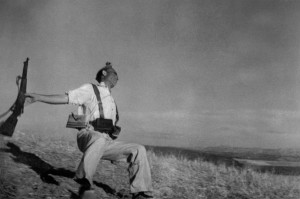At the age of 23, Robert Capa took a photograph that many have labeled the greatest war photograph of all time. Taken during the Spanish Civil War, the renown of Capa’s photograph, Falling Soldier or Death of a Loyalist Soldier, reverberated around the world as it was published and republished in contemporary news magazines. However, Capa’s photo has been shadowed by controversy, including accusations of fakery. Read an analysis on the image by Capa’s biographer, Robert Whelan, on the authenticity of the photograph. Do you find his arguments convincing? Do you think Capa’s photograph is staged or not? And do you think its authenticity matters? If you wish, you can compare Capa’s photograph to another controversial image.
Richard Whelan’s discussion of Capa’s photograph
To complete this homework assignment, please submit a post.
Please post your responses by Monday, December 11th.





Capa’s photograph, Death of a Loyalist Soldier,was not staged. The way the body fell and the placement of both hands made the image real. If a person falls, human instincts to place your hand down to support your fall. This soldier’s hands were at his sides and plus he was holding his riffle. In Whelan’s discussion a Captain told the fact that the fingers are somewhat curled toward the palm clearly indicates that the man’s muscles have gone limp and that he is already dead. It is nearly impossible for any conscious person to resist the reflex impulse to brace his fall by flexing his hand strongly backward at the wrist and extending his fingers out straight.